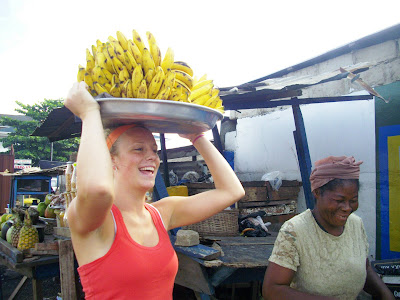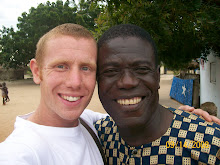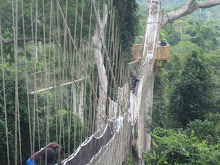

As my time here is Ghana is starting to come to a close, I find myself philosophically looking at what mark I have left on Ghana, and what mark Ghana has left on me. I know that many of the students here are wonderful; funny, energetic, creative, and they have certainly left an impression on me that will last for years to come. It is my hope as a teacher, that I have made a positive impact on them that will not be too quickly forgotten. As much as my year here has been about teaching, education, and students, I believe that it has been about something greater still.
The whole mission of the Fulbright program is to encourage and promote "mutual understanding between the people of the United States and the people of other countries of the world." This being stated, I have also found it to be true. My time here has been full of amazing adventures and experiences that will leave me with a lifetime of stories. None of those stories, adventures, or experiences would be possible if not for the connections made with other individuals. In my own thoughts on the topic, I keep coming back to the word “connections.” I am not sure how exactly to explain it, but here is a story that may help paint a picture.
One of the most rewarding experiences that I have had in Ghana thus far has been the connection I have made and friendship developed with the “Banana Lady.” Her name is Mary, but I rarely use it as I learned it 7 months after meeting her. Outside of Accra Girls’ School, at the entrance to Mamobi (a poor, but respectable, neighborhood) there is a women who sells bananas, oranges, pineapples, papayas, and groundnuts (peanuts). All of the fruit is beautiful. Just across the street, further away from the school, “Banana Lady” sells the exact same fruits for the same prices. When I first arrived here, I bought bananas and things from the lady just outside of the school, but I never made any connection with her and our dealings were always very business-like. One day I happened to walk by “Banana Lady”, bought some groundnuts and she was nice and we connected. Since then I will only buy from her. She is great and I love her. At lunch during the week I will go and sit with her on her bench, have a few bananas and some groundnuts, and just talk with her. Every time I travel she gives me a jar of groundnuts to take with me and she will always “dash” (give) me extra fruit. Most of the time she does not even charge me- a women who may make all of 4 or 5 dollars in a day will just give me fruit for free, knowing full well that I can pay easily. Sometimes I will take what she gives me, but then the next time, I will give her twice as much money as needed and tell her I don’t want change. I have introduced her to most of the other Fulbrighters and they will, on occasion, come and visit her. When I bought my moped, I stopped by and gave her a ride. Most Ghanaians that I have met want something, but she is just as friendly and as genuine of a person as I have ever met.
Now that my sister is here, each day we will go running together and finish at the Banana Lady’s stand. Often times the highlight of my day is the hour or so after my run. I usually feel pretty good and I sit with Mamobi Mary, the Banana Lady and my sister on the corner where she sells. Next to her, is a lady who sells corn each night and Evelyn, a 14 or 15 year old girl who de-tassels the corn for her. For that hour at dusk, my sister and I will help Evelyn de-tassel corn and talk about what she learned in school that day and what she wants to be when she grows up. We will play with the children that always seem to be at the corner; Patrick, Monica, and Regina. I tickle Regina until she smiles and yells, swing Monica until she is dizzy, and tease Patrick about being a Kotoko (a local soccer team that he hates) fan until he smiles and just shakes his head at me. The corn lady has taken to trying to give my sister and I each an ear of corn each night. She is quiet, but just as sweet as Mamobi Mary. Mary herself will sit and watch out for us and periodically yell to me that a passing trotro is going to Nima (a ghetto in Accra that is well-known to be full of thieves and criminals). She yells “Nima boy, this is your trotro.” I call her a “Nima Girl” and she says “No, no, no; Mamobi Girl” and then laughs like only Mary can laugh. All the while the pure water girls are dancing and chasing after one another and from time to time they yell to me “Hey, Nima Boy.” Each day before we go she tries to give my sister a mango, bananas, pineapple, or groundnuts. Never will she give me something, but always to Susan, knowing full well that I will probably be the one that ends up eating most of it.
However, the connection is stronger than just an hour or so each night. Whenever I go out to buy food on the street, I will always buy twice as much and split it with Mary. Usually, I will sit at her stand and eat with her while she sells bananas. In return, Mary has given me much more. On multiple occasions she has made dinner for me; when she goes to market to buy her fruits, she will always buy an avocado or two just for me, and when I finish running she is there to hand me a sachet of cold water. Before President Obama visited Ghana, I walked out to see Mary wearing a polo that had a picture of President Obama on the front and President Atta Mills of Ghana on the back. She was so very proud of it and when I told her it was very cool, she presented me with a one of my own. It is a second hand, stained, XXL, white polo with the two men’s pictures; a gift that I will treasure forever. That same day, in the evening, she, without me knowing, gave my sister a set of earrings and a matching necklace. In terms of Ghanaian standards, the jewelry was expensive. There was no talking Mary into taking any money for them. Instead, she did except the earrings that my sister was wearing in return. Each night she continues to try and give my sister some fruit or something out of the goodness of her heart. So many Ghanaians see Americans and want money or a visa, but Mary has never asked for either or for anything.
I have greatly enjoyed my time here in Ghana and in West Africa. The most rewarding experiences that I have had have been making connections with people. Of those connections, the one with Mamobi Mary, the Banana Lady, is truly the epitome of my entire Fulbright experience.




















